
MAY CONTAIN NUTS

Search Shorpy
SHORPY ART

Framed or unframed, desk size to sofa size, printed by us in Arizona and Alabama since 2007. Explore now.
Join and Share
Ad-Free Shorpy
Shorpy is funded by you. Patreon contributors get an ad-free experience.
Learn more.

Recent comments
- Better living through chemistry
- Beautiful composition
- Meh
- Amazing house!
- Robie House Roof(s)
- Move to Berlin and SAVE!
- There is an interesting novel set here.
- I Was In Berlin
- Pronunciation
- Shell of a Shell
- Never been there but
- BUR-lin
- Hand-made smokes
- Birthplace of Tupperware, or at least its inventor
- Pulp
- Remarkably unchanged in 84 years
- The church is still there ...
- Talk about a smoke show
- Electric Hansom Cab
- I wondered the same thing.
- The location in 2009
- Pill Pusher
- Roll your own
- Rugged and real!
- Civil War history
- Early EV?
- A Charles Purcell - Mama Cass Connection
- Uncle SAAM
- Obfuscation
- One Chocolate Soldier rode away
Member Photos
The Shorpy
Printporium
Printporium
Search Shorpy
Search results -- 30 results per page
- This Is Florida: 1955
- ... of slanted walls, bad wood paneling, and antique crappy hotel furniture, my parents said "Never again," and moved us on to a "name" hotel.
Ceci n'est pas un wigwam Those are teepees, not wigwams.
... Posted by Dave - 10/27/2019 - 3:30pm -
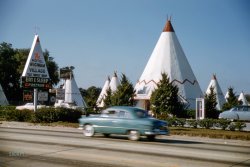
- King's Chapel: 1909
- ... of the Puritans is buried there. The famous Parker House Hotel is to the right of the church. Its history is more modern of course. Ho ... Minh once worked there and JFK has many connections to the hotel. The history goes on and on with this photo. Just behind the church is ... Posted by Dave - 08/03/2013 - 10:54pm -
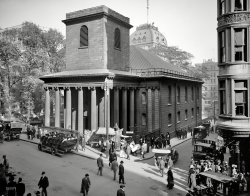
- Dreamland Twilight: 1905
- ... ladder fire truck had to save a full-sized six-story hotel constructed of iron that was set on fire.
... Posted by Dave - 07/20/2012 - 7:15pm -
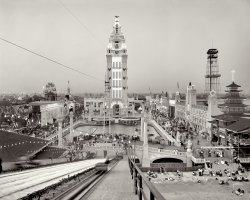
- The Rat Collector: 1908
- ...
The Rat Catcher You must read "Up in The Old Hotel".....otherwise this reminds me of "Rat ina Box, We Fry what You won't ... Posted by Ken - 09/07/2011 - 2:04pm -
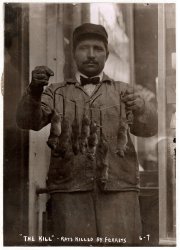
- Palais Royal: 1920
- ... It finally came down in the 1980's and the Renaissance Hotel now occupies the site.
The sidewalk glass blocks noted in another ... Posted by Dave - 07/03/2013 - 3:43am -
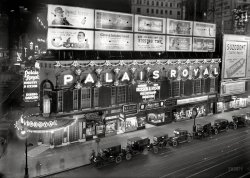
- The Spalding: 1908
- 1908. "Spalding Hotel, Duluth Minnesota." Next door to the more intimate Hotel Windsor. 8x10 inch glass negative, Detroit Publishing Co. View full ...
Urban Renewal The Spalding was a very fancy hotel, possibly the finest in Duluth. Its only real rival was about 6 blocks ... Posted by Dave - 08/06/2015 - 12:12pm -
![The Spalding: 1908 1908. "Spalding Hotel, Duluth Minnesota." Next door to the more intimate Hotel Windsor. 8x10 inch glass negative, Detroit Publishing Co. View full size.
Book Me At the Windsor, PleaseI like boutique hostelries, and it's significantly closer to a nice cold Blatz or ten.
Officer "Lamppost" MuldoonCenter stage, keeping an eye on the neer-do-wells.
[That's actually Officer Patrick "The Shadow" Muldoon. -tterrace]
Urban RenewalThe Spalding was a very fancy hotel, possibly the finest in Duluth. Its only real rival was about 6 blocks east, the Hotel Duluth.
As time went on it was enveloped by an area Duluth called the Bowery. This brought down the general appeal of the area and the Spalding fell on hard times. They kicked the less fortunate residents up to First Avenue in the early 1960's and tore down about a 3 block area along Superior Street in the name of Urban Renewal. None of the buildings in this area are there any more.
The building across Superior street, the KDAL building built after the renewal project has now been torn down to make way for a new corporate headquarters for Maurices, the clothing chain.
Interesting that there's a Great Northern Railway passenger office on the corner when the depot where their trains tied up was about a block away down the hill.
No vacancy.A nice history here.
(The Gallery, DPC, Duluth)](https://www.shorpy.com/files/images/SHORPY-4a22814a.thumbnail.jpg)
- Tonopah, Nevada: 1940
- ... right, with its sign partially obscured, sits the Mizpah Hotel (1907). Legend has it that that the two were the tallest buildings in Nevada from 1914 until 1927, when the six-story Riverside Hotel in Reno was completed. Both have been carefully restored.
... Posted by Dave - 10/11/2017 - 10:19pm -
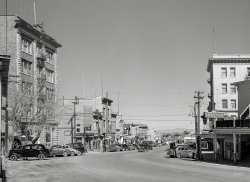
- The Hippodrome: 1905
- ...
Another landmark Did anyone notice the Algonquin Hotel in the background? Isn't it the oldest continuously operating hotel in the city?
(The Gallery, DPC, NYC, Railroads) ... Posted by Dave - 08/14/2012 - 8:24pm -
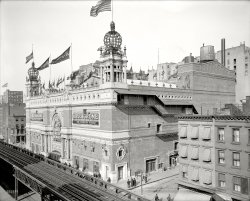
- Knott's Berry Farm 1958
- ... just a little smaller than a DO NOT DISTURB sign for a hotel, like train tickets, so the ride operator could punch it and it became a ... Posted by notycoon22 - 09/22/2011 - 11:29pm -
![Knott's Berry Farm 1958 Was reading an article by Steve Martin the actor/comedian in the New Yorker the other day and he mentioned that he'd started his career in show business at Knott's Berry Farm in the 60s. Wandering through some old family slides and, lo and behold, here's a shot from 1958. Predates Martin a bit, but I'm guessing it looked pretty similar. Oh, and that's my family on the right.
Photographer: Don Hall Sr.
Don Hall
Yreka, CA
View full size.
Thanks for posting thisAs a wee lad in the 1963-65 timeframe I went to both Knott's Berry Farm and Disneyland. Mouseville was much more entertaining, and all the photos and film clips set at Disneyland have reinforced my memories of that place.
But . . . why so little media attention to the Berry Farm? About all I remember of visiting there was learning they made jams and jellies.
Looks like a place I'd enjoy a lot more as an adult.
Knott's Berry FarmSadly, I can't remember Knott's Berry Farm, but I know I went to it and Disneyland when I was about 2-3 when we lived in Redondo Beach, Ca. in the early to mid 60's. But my mom loved it and often talked about it.
In GOD I trust, JOY
Knott's Berry FarmIn the 1960's the hippies started hanging out and sleeping in the trees and such. Fences were put up and then admission became the way of things. Before that the place was wide open. Some of the employees refer to those days as BH, for before hippies. I grew up near there and most folks in the area had very fond memories of the place. It is owned by big business now and just not the same.
Walter Knott's PlaceI went there during the 40's and 50's, when I lived in Manhattan Beach. There was no central admission point, you simply wandered from building to building. I believe the owners also owned Calico, a "ghost town" out in the desert.
Steven
Knotts Berry FarmI worked at Knotts on and off from 1956 thru 1960. It was all open when I worked there, but we had to move because my daughter, who was 2 years old, was allergic to the smog, and the doctors said she could lose her eyesight if we stayed there. I believe the fences went up and admission charged in the late 60's, because you could have picnics anywhere on the grounds, but no alcohol was allowed on the place when I worked there. People started drinking, leaving beer bottles on the lawns in the picnic areas, and abusing the Knotts family generosity. The Knott family treated their employees as family. I loved working there.. My whole family worked there. My dad Ed Kingsley was foreman of the stage line, my brother Eddie drove covered wagon, my mom Sibyl and sister Rita ran the burro ride. My brothers Dick and Treat robbed the stagecoach and covered wagons.
What fun memories, summers, by the time we got off work it was usually about 11 PM... Often all the cowboys from the stage line, the Indians and the girls from the Grill would head for Huntington Beach and build a big bonfire, roast hot dogs and marshmallows and body surf by moonlight. What wonderful memories I have of those days.. Or all of us heading to Pasadena for the Rose Bowl parade. Dad and his boss Bill Higdon driving stage, all heading to my aunt's afterward for waffles. I remember Bill Hidgon had long white hair and beard and always wore a red long sleeved shirt. My little cousins thought he was Santa Claus. I would love to step back in those times once more.
50 Years of visiting Knott'sMy family moved to the area in 1958. We started visiting KBF on a regular basis. It was all free then and we enjoyed walking around the ghost town. My brother & I usually ended up chasing the chickens around in the parking lot. Years later I "donated" two roosters, Charlie & Oscar, to their collection as we couldn't keep them at home anymore. A girlfriend's father, Russ Wildey, was one of the piano players in the old saloon in the early & mid 60's. I had an older female cousin who was dating one of the train robbers at that time. KBF was a lot of fun for us kids then. Actually I liked it a lot more before they fenced it in, but understand why it was necessary. I now take my grandkids there and love seeing them having their own fun.
Knott's Berry FarmIn the 1960s I would visit almost every day to listen to the Wagon Masters, the beginning of my love affair with folk music. I have been looking for their records (LP'S or any format). To my surprise on one of my visits back to KBF, the present employees of the park do not know The Wagon Masters.
[You should look on eBay. The group's name is the Wagonmasters -- one word. Currently there are eight Wagonmasters albums for sale. Click here. - Dave]
Married to a Wagonmaster!Hey email me...I'm married to Harvey Walker, back row, far right. I can tell you where you can get all the albums, now in CD form. Thanks for remembering them. Rachel has passed away, as well as Bobby (back row, far left. KC@KCDOUGLAS.COM
Train robbers.My sister and I went on a road trip with our grandmother and her sister from S.F. Bay Area down to see Disneyland around 1958. That was one long trip in those days. Disneyland was great of course, but I really liked Knott's Berry Farm. I was 5 years old, and cowboys were a big deal for kids my age. It really felt like I was back in the frontier days.
So we decide to take the train ride, and everything was really neat. The all of a sudden, these two guys in masks kick in the door to the train car we were on and shoot off their guns and yell out that this is a robbery.
Well nobody told me that these guys weren't actual train robbers, and I was scared out of my mind. All could think off was, "Please don't kill my Nana." The panning for gold was also a big hit with me. I'm pretty sure I still have the little tube with gold in it stashed somewhere.
Russ Wildey, my dad.Russ also played piano at Disneyland, Shakeys, and the Gaslite Lounge in the 1950s & 60s. Born in 1900, he was most famous in the 1920s. He and his partner Bill Sheehan were known as the Ray-O-Vac Twins. They worked for RKO Radio making appearances across the country and playing live broadcasts. Bill sang while Dad played the piano. Their sheet music is still sold online. It's fun to see his picture on the covers, looking so young. Dad passed away in 1964, I was 13.
The Good Old DaysIn 1968 the fence went up around Knotts Berry Farm. I remember because I was ten but my best times there were when it was still an open park. It had been an open park dating back to when it was not much more than a berry farm and berry stand on the side of the road in the 1920's. They served boysenberry pie, that was the only berries they grew or sold. No one else grew or sold boysenberries so it was quite unique and soon the crowds came. By my time it had already grown into a successful theme park many years earlier. But I do remember the days in the 1960's when Steve Martin not only played at the Bird Cage Theater but would walk to the stunt man show and do their crowd warm-up. He would joke around while people came in to find seats in the covered wagons that surrounded the stage and then joke around a little with the stunt men at the beginning of the show. He wore a giant funny cowboy hat, like they do at football games now, and I remember him being the funniest guy I've ever seen. So I've literally been a fan of Mr. Martin from the beginning.
As far as Knotts Berry Farm goes, there were nice tree covered parking lawns on three sides and you could enter the park from all sides. The front entrance was the most popular because that's where the restaurants and shops were (and still are). They also used to have a San Francisco style cable car (on a track) that ran to the front parking area and dropped you off right in the center of the park between the train depot and stage depot. You bought attraction tickets at various ticket booths just like you would at a neighborhood carnival and they were just a little smaller than a DO NOT DISTURB sign for a hotel, like train tickets, so the ride operator could punch it and it became a souvenir. They were used for the train, stage, calico coal mine ride, haunted shack, mule ride, and various old-style amusement park rides.
There was also Old MacDonald's Farm with a petting zoo and a chicken that would play the piano if you dropped a nickel in a slot to release feed on the keys. There was an organ grinder with a monkey who would untie your shoes and take your dime, and a goat that always seemed to be standing on the peak of the barn roof.
Free attractions included lots of historic structures including the original Knotts Berry stand, a real country church with steeple that held the only regular services within an amusement or theme park (also weddings), a small chapel created by a local artist that showed the transformation of Christ via a wall to ceiling stained glass and special effects lighting and music. Lots of little narrated shows like a 3D panorama showing Mrs. Knott's grandmother crossing the desert in a covered wagon and begging for water. It was only six minutes long but after the little girl cried "mommy, can I please have a drink of water" and her mother replying "I'm sorry we have to save it for the horses, try to get some sleep now" there wasn't a dry eye in the house. Models of all the missions in California were depicted in scenes along a covered walkway, I doubt any kid would stop to look at those today. There were shootouts to watch and you could get your picture taken with saloon girls or the Indian chief (who would lend you a feathered headress), you could watch the blacksmith make a horseshoe, pan for gold (you would get to keep the gold dust in a little bottle), watch a corpse rise from the undertakers carriage, walk around boot hill, and talk to Sad Eye Joe in his jail cell who despite being just a stuffed dummy, spoke to you and always knew your name and everything else about you (he's been there since 1940 but if your parents aren't there talking to his partner around the corner he might not remember your name). Some of that still exists, but basically its just Knotts in name only, quite a different park exists there now and much of what I described torn down or slated to be torn down.
The jellies are now owned by Smuckers and the park by Cedar Fair who's opinion is if its not a fast ride, bulldoze it down, historical who cares. The old church which looks like a Thomas Kinkade painting is being destroyed because they don't want the expense to move it. The old chapel was torn down and the artwork (smashed?). Founder Walter Knott was such a lover of American history he built a replica of Independence Hall in the 1970's including the Liberty Bell and a tour that recreates the signing of the Declaration of Independence. Cedar Fair decided to keep it because it was so accurate Hollywood uses it for movies (National Treasure, for example) and it pays for itself that way.
I remember learning a lot about history at Knotts Berry Farm and what it was like to live a hundred years in the past. I learned it was all about the various people who were each distinct characters in the town. Now its just about indistinct roller coasters with indistinct roller coaster operators and indistinct roller coaster riders having indistinct roller coaster experiences that will last as long as it takes to run to the next roller coaster.
Old Church ChapelMy mother worked in the Chicken House around 1959-1960. I remember as a little girl going to a little Church Chapel with big doors that opened and you would go in and sit down and see and hear a story about Jesus. Does anyone know if that little church is still there? I also remember feeding the seals after Momma got off work.
(ShorpyBlog, Member Gallery)](https://www.shorpy.com/files/images/KnottsBerryFarm1958mr.thumbnail.jpg)
- The Cat's Pajamas: 1940
- April 1940. A hotel room in Dubuque is the setting for this untitled self-portrait of ... do when they sleep-walk.
Photographer for hire Hotel rooms a specialty.
https://www.shorpy.com/node/25134
Feeling ... Posted by Dave - 11/13/2019 - 1:25pm -
![The Cat's Pajamas: 1940 April 1940. A hotel room in Dubuque is the setting for this untitled self-portrait of photographer John Vachon. Medium format acetate negative. View full size.
Cell Phone ChargerIt's not, but then again, what is it?
Belt and suspenders.Can't be too careful!
re: Cell Phone ChargerIt's a little difficult to tell because it's out of the picture's depth of field, but my guess is that the wire shaped contraption on the dresser is a shutter bulb, or at least part of one.
One Heck of a SuitcaseLooks like he doesn't believe in traveling light, and we don't even see his photo gear.
I want a big oneThat suitcase is worthy of George Bailey, when he dreamed of hopping aboard a tramp steamer and seeing the world.
Phone charger?How about a light meter?
[On the right, yes, but the cord in question is over on the left. - Dave]
Not a phone charger for sure.Could it be what attaches to the flash from the camera?
Phone Charger?My vote is for timed shutter release, or similar contraption.
Awake?So that’s what photographers do when they sleep-walk.
Photographer for hireHotel rooms a specialty.
https://www.shorpy.com/node/25134
Feeling foggy in DubuqueIn a letter to his wife on April 18, 1940, Vachon complained, "Changing film is a difficult problem, no closets, no light proof toilets. Fear I fogged some under the bed clothes this afternoon."
Source: John Vachon's America, Photographs and Letters from the Depression to World War (Edited, with Introductory Texts, by Miles Orvell)
It IS a phone chargerAnd that's a vape pen on the stack of books.
(The Gallery, John Vachon)](https://www.shorpy.com/files/images/SHORPY-8c17017a.thumbnail.jpg)
- Paws ... Drink: 1941
- September 1941. "Cattle country and rural scenes. Hotel in Big Piney, Wyoming." Acetate negative by Marion Post Wolcott for the ... Posted by Dave - 04/14/2021 - 5:37pm -
![Paws ... Drink: 1941 September 1941. "Cattle country and rural scenes. Hotel in Big Piney, Wyoming." Acetate negative by Marion Post Wolcott for the Farm Security Administration. View full size.
Very expressiveI love the way the dog and the man have the same intent gaze directly at the camera. They also have eloquent faces.
What a study in casual dressing the man is! His tie needs retying to even it out; better yet, it needs replacing with a clean, pressed tie. His shoes haven't seen a good brushing or polishing in some time, and his trousers want pressing (and tailoring). Perhaps he has no wife.
Have I diedand gone to Shorpy heaven? I think I hear angels singing. Where to start? The faces in the windows ... two gents looking at the dog, and the young man (I think he's a male but he's pretty enough to be a female so who knows) between them, with the gorgeous eyes, looking straight into the lens ... the fellow in the right-hand window peering out at the old codger with the comically short tie standing there all defiant like, as if to say go on, step into me and see what happens ... that wonderful DOG, so sweet, so still and patient ... whose hat is that on the bench? I am babbling but it's with sheer joy. Thanks for this treasure, Dave. I will be back to drink deeply of its charms again and again.
[ ♥, ♥, ♥. - Dave]
VamooseThe ultimate stare-down. "Forget about coming back for your hat!"
My dog's great-great-great-great-great-repeat grandmother? That perky little dog looks just like mine except for the pointy ears. I guess her heritage goes back to pre-war Wyoming. What an amazing photo. I want to know what those people in the window were thinking.
The Last Picture Show?Not quite. Seen in the ripple of the glass reflection is the handsome facade of the then relatively new Gaiety Theater, a movie house that opened in 1938. Maybe the fellas were in town for some stock sale, to grab some feed and then perhaps take in a show? The curtain fell when the Big Piney Gaiety was demolished in 1982.
Stained glass windows no lessAnd Mark McCain from the 'Rifleman' in the window on the left. Where's Pa?
Like a rockMud-splattered 1938 Chevy workhorse with evidence of some grille damage.
A perfect complement to the imposingly assertive old rancher sharing the scene.
Oh, those details --I'd like to know what the rumpled Gary Cooper has in his shirt pockets. My first idea was that it was his false teeth, but he doesn't look like he's missing those. It's most likely a bag of Bull Durham, with papers in the other pocket. And isn't it nice that Chesterfield advertised itself as the cigarette of kayakers?
If not for his short necktie... this fellow's rugged casual style would not be out of place in 2021. It seems to me that ties have gotten consistently longer over time; maybe someone can be more specific.
Further reflectionsI believe I see Ms. Wolcott reflected in the window on the left; the beautiful boy is looking directly at her. And notice the reflection of the man standing out front ... his left shoulder (our right) and part of his hat brim is seen in the lower left-hand corner of the right-hand window. It doesn't seem possible given the angle, but it undoubtedly is him, based on the bit of his coat collar sticking up.
Also upon further reflection, I do not think that the man at far left is looking out at the dog. I believe he is looking at the beautiful boy.
This photo is too wonderful for words, and yet I found some. More.
One Life To LiveUnfortunately, that cute l'il pup is long gone. But if he were a cat on his first or second life, why he'd still be alive with a life or two to go today!
When I see a short tie like that I always think of Lou Costello! But that fellow reminds me of the wonderful character actor Harry Carey.
Vera GilmerChesterfield’s Girl of the Month. (Note lit cigarette in right paddling hand.)
A Top 10 Shorpy pic for meLong time lurker here. First ever comment. I have tossed a couple bucks in the donation box a time or two. Just wanted to say this is a top 10 Shorpy pic for me. So much going on. What fun it would be to be dropped into that moment in time knowing what we know now, and knowing you'd return to present day. Look into the eyes of each. What happened to get them to this moment and what followed in their lives? Sigh.
(The Gallery, Dogs, Eateries & Bars, Frontier Life, M.P. Wolcott, Small Towns)](https://www.shorpy.com/files/images/SHORPY-8c15881a2.thumbnail.jpg)
- West Side Cowboy: 1911
- ... This location is now the west side of the luxury Standard Hotel.
This photo of the arrival of Lusitania on her maiden voyage in ... Posted by Dave - 09/08/2011 - 7:26pm -
![West Side Cowboy: 1911 Equestrian signalman on the New York Central's Eleventh Avenue freight line circa 1911. In a 1930 article on the West Side tracks' demise, the New York Times wrote of the "eight men and twenty-four horses comprising the famous 'cowboy troop' [or 'West Side Cowboys'] whose function it has been for years to ride ahead of the puffing locomotives as they wheeled along Death Avenue." The dangerous street-level tracks were eventually replaced by a 1½-mile viaduct, the High Line, that after decades of abandonment is being turned into a long, thin elevated park. View full size. 5x7 glass negative, George Grantham Bain Collection.
Pegleg?Does the man in the right-hand background have a peg instead of a foot?
[Could be. - Dave]
Actually...Peg was his wife; his name was Ben; Ben Cobble. No, really.
Peg leg?I think he does have a pegleg.
11th Avenue LineI have been looking into the locations of the "11th Avenue" photos and think that this one is also on 10th Avenue, though much lower than the other two. This one is at 13th Street, looking south (see "13th Street Market" wording on awning). Eleventh avenue doesn't even exist this far south. The map showing these buildings, 32 and 34 10th Avenue, is Plate 10 of the 1911 Atlas. This building faces the marginal street by the Hudson River piers which had just been renovated in the decade-long "Chelsea Improvement" that enabled very large ships to dock. In 1912, Cunard's Pier 54 across the street from this building would welcome the ship Carpathia after she disembarked Titanic lifeboats and survivors at White Star Pier 59. In May of 1915 the Lusitania departed from Pier 54 on her final voyage. This location is now the west side of the luxury Standard Hotel.
This photo of the arrival of Lusitania on her maiden voyage in 1907 (before the completion of proper pier sheds) appears to have been taken from the roof of this building or one nearby.
[I'd say the labels on the negatives reflect the fact that the line was called the 11th Avenue Railroad because that's where most of it was, or at least the most dangerous part was, even if stretches of it were on other streets. - Dave]
About that cowboyCalling them "cowboys" was the railroad's attempt at being polite. The locals called them "dummy boys" as they led the shrouded steam locomotives, called "steam dummies" so as not to spook the local horses. Grandfather and cousin told me a few stories about those guys.
ObservationsStarting at bottom right and moving up through the picture, before ending apparently under the boxcars, we have the remnants of a former trolley line. Since much of NYC disallowed the use of overhead wires and instead used the "slot" system, we can tell this line is somewhat recently abandoned. The rails have been removed, with them and the "slot" filled in by bricks.
Looking at the path of the former streetcar line, we can see that at some point it would have passed up by the Strauch brothers building, probably connecting with another line at the far end of the triangle shaped area.
The Swift company used overhead loading tracks to move goods from the cars and into the shop or vice versa. You can barely make out this system under the awning.
Whereas most steam dummies were Shay-type geared locomotives, this one predates that and is a squat Tank type.
(The Gallery, G.G. Bain, Horses, NYC, Railroads)](https://www.shorpy.com/files/images/02886u.thumbnail.jpg)
- Dallas: 1942
- ... Sanger Bros. being an exception): "Old Red", the Adolphus Hotel, Magnolia Petroleum and Santa Fe Buildings still grace us with their ... Posted by Dave - 09/22/2022 - 4:48pm -
![Dallas: 1942 January 1942. "View of Dallas, Texas, going eastward on U.S. Highway 80." Medium-format acetate negative by Arthur Rothstein for the Office of War Information. View full size.
I hate downtown DallasFor such a relatively new city, downtown Dallas is surprisingly difficult to get into, navigate, and get out of. First, the whole downtown is shifted about 20 degrees off the grid of the rest of the city. I'm attaching a map. Notice no major streets run straight in and out of downtown. You have to navigate your way. Once you're there, there are only three streets that run end-to-end north and south. Those three streets are the three under the train tracks to the left in the 1942 photo. Commerce on the right is a one-way into downtown, then Main, then Elm is a one-way coming out of downtown. At both ends, those three streets funnel into one. Who thought of this?
Coming out on Elm, if you miss the exit to get on 35E (on the left in Google Street view), you're headed to the other side of the Trinity River. It can be very unforgiving. East and west are just as badly planned. That loop where you see International Center is usually a total pain to get through.
I've lived in old cities and cut them some slack. Dallas is way too new for the downtown to be this badly planned.
But it does show nice from a distance.
Yes, THAT underpassIt's the first one on the left ... in fact the only one on the left (as goes the old joke).
The scene today is not dissimilar; well other than a whole new skyline being added -- but not much has been subtracted (the Romanesque building of Sanger Bros. being an exception): "Old Red", the Adolphus Hotel, Magnolia Petroleum and Santa Fe Buildings still grace us with their presence.
An infamous location on the left.Dealey Plaza is just beyond the underpass.
Focus of conspiracy (theories)The Triple Underpass, with the streets clearly labeled: Elm, Main, Commerce. Just beyond, the Grassy Knoll--yes, now capitalized--with some of its tree tops visible at far left.
Prominent Building on the LeftYep, that's the Texas School Book Depository.
[Nope, that's the Dallas County Criminal Courts building. - Dave]
Wikipedia identifies the Dallas County Administration building as formerly the Texas School Book Depository.
[Which is next door to the Criminal Courts building. - Dave]
This perspective should helpThe building you can clearly see in the 1942 photo is the Dallas County Criminal Courts building. Here is a Street View from the X on Elm Street marking where President Kennedy was shot. The now-infamous School Book Depository is on the left. Lee Harvey Oswalt Oswald fired from the far corner window, one floor below the top. I believe you can see just a sliver of this building on the far left in the 1942 photo. On the right is the Criminal Courts building.
Re: Prominent Building on the LeftWhen I saw the post this morning my first thought was that, yes that was the Texas School Book Depository, but when comparing it to the attached photo I don't think it is.
(Panoramas, Arthur Rothstein, Cars, Trucks, Buses)](https://www.shorpy.com/files/images/SHORPY-8b16340a1.thumbnail.jpg)
- Carnaval Cabrillo: 1913
- ... California, 1913. "San Diego and bay from U.S. Grant Hotel." 8x10 inch dry plate glass negative, Detroit Publishing Company. View ... Posted by Dave - 04/14/2017 - 10:22pm -
![Carnaval Cabrillo: 1913 San Diego, California, 1913. "San Diego and bay from U.S. Grant Hotel." 8x10 inch dry plate glass negative, Detroit Publishing Company. View full size.
Can you tell meas a non-resident, and very astute perusal of this scene, what country is it located?
Those two warshipsI believe Those two warships in the background are Pennsylvania-class cruisers. They were all stationed on the west coast at that time.
June 14th or July 4thLooks like it was either around Flag Day or Independence Day judging by all the patriotism on display and I will bet that all those flags were not made in China either! Put that in your bong and smoke it!
[Look at the banner in the photo and you'll see that it's September. - Dave]
West Coast Armored CruisersThe two warships are the USS California and South Dakota (I can't tell which is which, though). These Pennsylvania class armored cruisers were built at the Union Iron Works in San Francisco (the 1906 completion was delayed by the earthquake) and stayed on the west coast most of their early life.
On an historical note, the California will have its named changed to San Diego a year after this image was taken. The ship will then be sunk off of Long Island on July 19, 1918. For the next 80 years historians will argue whether it was hit by a torpedo or a mine from a German submarine, but new evidence has emerged that a German spy planted a bomb onboard.
Not the FourthI thought this was a Fourth of July picture until I paid attention to the title. Here's some history on the actual event.
Cabrillo and San DiegoJuan Rodriguez Cabrillo's discovery of San Diego Bay on September 28, 1542, inspired San Diegans to organize a festival and parade in 1892, a much larger pageant in 1911 as a fundraiser for the 1915 Panama California Exposition, and the four-day Carnaval in September 1913 that this photo commemorates. The 1913 event celebrated the dedication by President Woodrow Wilson of federal land at the tip of Point Loma as the Cabrillo National Monument, overlooking the entrance to the harbor in the upper left corner of the photo. The actual monument would not be built until 1939, but the medal seen here was struck in 1913 for the event. The 1911 celebration featured a lot less less history and a lot more fun, and included the fantasy arrival of "King Cabrillo" at the court of "Queen Ramona." The royal mascot's name is not recorded.
+87Below is the same view from July of 2000 (scanned from a slide - an art I'm still attempting to grasp). The structure on the left that still stands is the Spreckels Building. Interestingly, American naval power is also contrasted in the two shots. I don't know what ships are in the distance in the 1913 shot, but they can be compared to the USS John C. Stennis which has its fantail visible in the distance in the 2000 view.
Armored CruiserThe ship in the center of the picture appears to be an armored cruiser of the Pennsylvania class. It's quite possibly the USS West Virginia, which was stationed along the West Coast at the time the photo was taken.
Ship IDI believe the ship in the background is the USS California (ACR-6), a Pennsylvania-class armored cruiser. She was renamed USS San Diego in 1914 and was sunk by a suspected mine off Long Island in 1918.
TransitionAnother picture showing the transition from four legs to four wheels and it shows that the auto is winning. BTW, check out that spiffy roadster in white; it stands out like a Rolls at a Yugo Convention.
1913 Auto Show Interesting contrast in those cars parked head on in front of the 2nd building. The one white topless car parked amid all the apparently black autos.
Keystone State Taken to the CleanersSince those Pennsylvania-class cruisers spent most of their careers in the Pacific, I hope Pennsylvania got its money back!
The flag I loveThis is a great picture, if only for the presence of all those beautiful, wonderful, brand new 48-star flags!
(The Gallery, Boats & Bridges, Cars, Trucks, Buses, DPC, Streetcars)](https://www.shorpy.com/files/images/4a24661a.thumbnail.jpg)
- BPL: 1908
- ... But you're still on your own finding a parking spot. The Hotel Lafayette, at right in 1908, is still there.
Swing to your left if ... Posted by Dave - 09/19/2022 - 8:54pm -
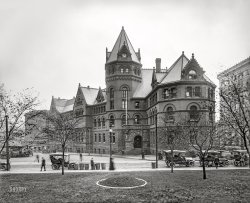
- Socks Workers: 1941
- ... mill in Union Point . Nearby we may find the Terrace Hotel . Finally a connection to tterrace 's nickname?
Sock it to me ... Posted by Dave - 02/18/2019 - 9:40pm -
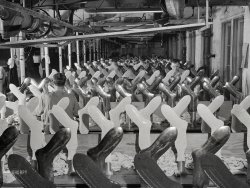
- Tremont Street: 1923
- ... the Chevrolet sign is either atop the Tremont House hotel, or across Beacon St. on the building that was leveled in the 1970's for ... Posted by Dave - 07/17/2012 - 10:40pm -
![Tremont Street: 1923 Boston circa 1923. "Tremont Street and the Mall." One of the later entries in the Detroit Publishing catalog. Note the big Chevrolet sign. View full size.
Boston BravesSeeing the sign "Baseball Today at Braves Field" jogged my memory.
As a kid collecting baseball cards in Cincinnati I can remember when they moved to Milwaukee in 1953 and their home field was in County Stadium.
I also remember when they moved from Milwaukee to Atlanta.
Still recognizable todayProminent is Park Street Church. The two granite subway kiosks hide a mirror image pair. The visible ones were removed decades ago. Many of the buildings are still there but with extensive modernization. Ah, the 1920s, when women weren't afraid to show a little leg!
Packard & HudsonThe first two cars parked on the near side of the street are a circa 1919 Packard with a 1920-21 Hudson Touring Limousine behind.
+85Below is the same view from May of 2008.
1923 or 1928?I'm certainly no fashion expert, but something about the way the ladies are dressed says late Twenties.
[The rubber says Early to Mid Twenties. If it were 1928 the cars would have balloon tires. - Dave]
Ain't she sweet?The woman in light colored clothing is turning more heads than the photographer. No doubt her companion is equally well turned out but she is mostly obscured by the man who was walking between her and the photographer's lens at the moment the shutter was opened.
Fashion datingKnee length skirts didn't come along until 1925 - circa 1923 they were way longer.
Date of PhotoThe 1923 posted date could be valid. Except for the front car, all the other nearby cars are sporting a POV 1922 Massachusetts license plate. The front car (a Packard) looks to be a Taxi - therefore it could have a different plate.
Too early for neonIf that Chevrolet sign is neon, then 1923 would be almost certainly too early for this photo. Neon signs were only introduced to the US in 1923, and it's unlikely that Boston would have had one of the first in the country.
[It uses light bulbs. - tterrace]
Boston 1924This photo, dated 1924, does not show the Chevrolet sign (from a different angle, but for reference match the Coca-Cola sign to the Salada Tea sign in this photo.) Photos dated 1927 and later in that set do show the sign.
1928 without a doubtThe third car in, the one with the street sign in front of it is a 1928 Essex, the one in front of that a c.1921 Hudson, and the first car, the black one, is a 1926 or 1927 Packard. The The Essex and Packard DO have balloon tires. And no respectable women in Boston would have worn skirts so short prior to 1925.
Tremont St. Boston ca1923.The R.H. Stearns department store, right side of Tremont, stands today as elderly housing. Is the wireless antenna structure in the background on the building closer to us than the Tremont Theater (later Tremont Temple), on atop the Theater itself? TIA
It appears the Chevrolet sign is either atop the Tremont House hotel, or across Beacon St. on the building that was leveled in the 1970's for the 1 Beacon St. highrise, home of the Boston Gas Co. and an underground, 2-screen Sack's cinema. HTH.
(The Gallery, Boston, DPC)](https://www.shorpy.com/files/images/SHORPY_4a24958a.thumbnail.jpg)
- The Big Apple: 1912
- ... the Woolworth tower. And let's not overlook the Hotel Grütli. Detroit Publishing Company. View full size.
Survivors ... With trains on either side of the building, rooms in the Hotel Grutli would have had good, good, good, good vibrations.
Tall, ... Posted by Dave - 07/18/2012 - 6:56pm -
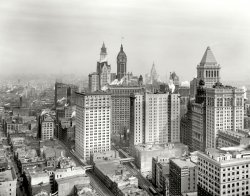
- Brattleboro Blizzard: 1940
- ... And because this is Shorpy, the picture was taken from a hotel (Hotel Brooks) which later caught fire. Fortunately, that building is still ... Posted by Dave - 05/08/2019 - 1:26pm -
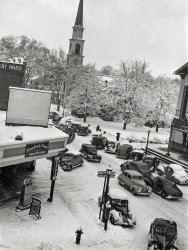
- .. : 1920
- ... in a charity performance of "Coppelia" held at the Plaza Hotel on January 27, 1920, a benefit for the Orphaned Babies' Home. The amateur ... Coppelia last night, staged in the large ballroom of the Hotel Plaza."
You Got Me OK - that title took me a little while to ... Posted by Dave - 10/04/2012 - 10:28am -
![.. : 1920 New York circa 1920. "Dorothy Leary & Dorothy Quinn." 5x7 glass negative, George Grantham Bain Collection. View full size.
Double Doh!At first I thought it was braille. Yes, computer monitor braille.
Dancing Dolls at the PlazaThe photo appears to document the costumes of two socially prominent debutantes who appeared in a charity performance of "Coppelia" held at the Plaza Hotel on January 27, 1920, a benefit for the Orphaned Babies' Home. The amateur performers were all alumnae of Miss Clara Spence's School for Girls on West 48th Street, and the production was staged by the Metropolitan Opera's truly game choreographer, Ottokar Bartik. As usual for this kind of society event, the New York Times lead paragraph described those who attended as a "brilliant assembly," but included a rare and brilliant typo in the lead sentence: "A brilliant assembly witnessed a survival of the ballet Coppelia last night, staged in the large ballroom of the Hotel Plaza."
You Got MeOK - that title took me a little while to figure out. Touché.
Doh!It's the two Dots. NOW I get it.
Alternate Title: 1920
Period humorSometimes it's hard to get the point.
[Punctuation! - Dave]
Oh, Doctor!I see Dots before my eyes!
The Evil TwinWhen comparing the two, the standing Dorothy seems to be rougher around the edges. A sterner face, frizzier hair, and wrinklier dress. Where the sitting Dorothy seems sweeter, softer and smoother. And look who got to sit down for the picture.
I've had itI told you I wanted to sit in the chair. Standing Dot appears a little angry.
Re: Period humorDave and tterrace have set the barre high for the next calembour.
(The Gallery, G.G. Bain, Portraits)](https://www.shorpy.com/files/images/SHORPY_30137u.thumbnail.jpg)
- Lake Worth: 1897
- ... circa 1897. "Lake Worth, south from the Royal Poinciana Hotel." 8x10 inch glass negative by William Henry Jackson. View full size. ... the right side of the lake. However, that would mean the hotel was either in West Palm Beach or the picture is reversed.
Perhaps ... Posted by Dave - 01/30/2019 - 3:49pm -
![Lake Worth: 1897 Palm Beach, Florida, circa 1897. "Lake Worth, south from the Royal Poinciana Hotel." 8x10 inch glass negative by William Henry Jackson. View full size.
Interesting JuxtapositionI don't mean to be pedantic, but this picture is very confusing.
The map shows this would be West Palm Beach according to the lake's location in the picture. There is a causeway across the lake called Royal Poinciana Way and there is a similarly named shopping area on the right side of the lake. However, that would mean the hotel was either in West Palm Beach or the picture is reversed.
Perhaps another reader will clear this up.
[Turn your map upside down. In the photo the mainland is to the right. - Dave]
That would be true if the lake ended not far past the hotel. In the picture it appears to go on much farther.
[Lake Worth, which is not really a lake, has no beginning or end -- it's a lagoon on the Intracoastal Waterway. The hotel was around where Royal Poinciana Plaza is on the map below, on the inland side of the giant sand bar that is Palm Beach. - Dave]
Built with no power tools.I'm always impressed with that. Not to take away anything from today's tradesmen, but they needed some extra skills back then.
Whenever I hear people complaining about automation killing jobs, I ask them how they would like to do things the way they had to 100 years ago.
No thanks!
Roof ladderImagine having to climb out there to raise the flag every day.
An Old MapHere's an old real estate map from 1907 showing the Lake and an inlet at the north end of Palm Beach. Until the mid 1800s the Lake was a fresh water lagoon.
Click to enlarge.
(The Gallery, DPC, Florida, W.H. Jackson)](https://www.shorpy.com/files/images/SHORPY-4a03612a.thumbnail.jpg)
- Our Town: 1905
- ... Wine House, The Baltimore Lunch Room and the Pittsburgh Hotel.
California Wine Wow. A California Wine House in 1905. Napa ... Posted by Dave - 08/13/2012 - 6:10pm -
![Our Town: 1905 Circa 1905. "Seventh Street at Cedar, St. Paul, Minnesota." 8x10 inch dry plate glass negative, Detroit Publishing Company. View full size.
All Over the MapOn this St. Paul street we have The California Wine House, The Baltimore Lunch Room and the Pittsburgh Hotel.
California WineWow. A California Wine House in 1905. Napa Valley, I'm sure -- my mother was born in St. Helena and my grandmother was the cook in the St. Helena High School at this time.
Other commenters have noted the near-absence of women in some pictures of this era. Another thing that strikes me in these pictures is the almost total absence of people smoking in public. This, of course, changed after the increase in tobacco usage after WWI. Keep it up; these pictures put flesh on the bones of history.
Vanishing PointI haz it.
Lunch RoomThe "Lunch Room" shown here is the first I have seen of this term since my father-in-law died.
The detail in these photos is absolutely great. I can study then for hours and still not see it all. Keep up the great work.
AhemI believe it's just as possible that Sonoma wines were represented in the shop, as that's where the California wine industry started. Just sayin.
Rip Van WinkleThis photo has a giant Rip Van Winkle sign and the next one is of an actor whose most famous role was Rip Van Winkle.
Intentional Shorpy shenanigans or pure happenstance?
[Shorpy is all about thematic unity. - Dave]
ClocksI love the clocks that look like giant pocket watches. They aren't synchronized but pretty close!
[Those are painted signs. Right twice a day! - Dave]
Plenty of GalsThere seems to be a good representation of the fairer sex in this photo. I count at least 22. Given that relatively few women worked (outside the home) at this time, that's a good number.
Miss Percy HaswellWhat role could she have been playing in "Rip Van Winkle"? Certainly not the lead! She was described by one contemporaneous writer as "so blonde, so blue-eyed, with voice so throaty sweet. She was a lass from Austin, Texas, but to me she seemed to belong to some other world altogether."
Looking west on 7thThe building on the left, Stein and Co., would be replaced in the 1950s by a new W.T. Grant store. Farther down the street, on the right, is the Emporium department store. It would later relocate down the street, on the left, to occupy an entire block between Robert and Jackson streets.
(The Gallery, DPC, Minneapolis-St. Paul, Stores & Markets, Streetcars)](https://www.shorpy.com/files/images/4a12312a.thumbnail.jpg)
- Pontiac Purveyors: 1936
- "1936 Pontiacs and salesmen at the Mark Hopkins Hotel, San Francisco." Lined up at the Bottom of the Mark. 8x10 inch Kodak ... Posted by Dave - 12/17/2014 - 9:03pm -
![Pontiac Purveyors: 1936 "1936 Pontiacs and salesmen at the Mark Hopkins Hotel, San Francisco." Lined up at the Bottom of the Mark. 8x10 inch Kodak safety negative. View full size.
Third Car is a 1935 ModelThe third car with the headlights attached to fenders and different insignia is a 1935 model. Could this photo have been taken in late 1935 when the 1936 models were introduced?
Fender sittingDon't try that on your new car today, you'll wind up with dents.
Car number 3Is a '35. Guessing that #4 is your base model with no straight 8 engine or emblem, and painted as opposed to chrome grille.
Some are new, some are notVitojo, the two that have the headlights mounted to the fenders are 1935 models; the rest are '36 models. Notice also that on the '35 models, the side elements of the grilles contain vertical bars, instead of the horizontal bars seen on the '36 models.
Cool hood ornamentThat Pontiac hood ornament; the Indian w/the ring around it was very fragile --I wonder how many were intact a year later
Different PontiacsThe third car from the front is a 1935 Pontiac. It is very similar to the '36s. The '35 introduced the first "turret top". The most noticable difference was the front door hinge location, which was moved from the front to the back.
Re: Third car from the front or the backI think the car with the headlights not attached to the nose is a 1935 model while the others are 1936. Someone near my house had a 1936 Pontiac similar to these for sale last year. I would drive by and think how great it would be to own something like that, but boy you would have to know a lot about old cars (and where to get parts!) to maintain something like that.
What no tailfins?I was born just as cars were starting to sprout tailfins, but if asked to draw a car today, one representing all, this is the silhouette that comes most often to mind. A lasting design statement.
I love those grillesI do, I do, I do.
"The wheels will fall off", as Mom would sayMy father, a genius certified by the U.S. Army, loved Pontiacs, even more than the Cadillacs, Studebakers, and Jaguars he'd owned. Perhaps it was the adventure aspect--searching for mechanics in the most remote scenic byways of pre-interstate America. All of us kids remember vividly our made-up games of collecting bottlecaps to while away hours as Dad and the Sinclair greasemonkey reattached the wheelhub of our '56 Chieftan, our '59 Starfire, our '63 GTO or our '66 Bonneville so we could get on with our vacation. It was no wonder that whenever Dad came home grinning with the new one, Mom would say simply, "The wheels will fall off".
Heading home two weeks ago, the turn lane onto my street was blocked by a police cruiser. "An accident", I thought. But no, the officer was merely protectively blocking off traffic for a man in one of the last Pontiacs built, its right front wheel, hub and all, detached and lying over on its side nearby.
Dad finally admitted at age 80 that Mom was smarter.
Nevertheless, one of my fondest memories is as a child of three, driving my uncle's hot pink '56 Pontiac down the brick streets of Amarillo, Texas, with my mother and aunt in the back seat asking, "Do you think this is a good idea?" Thank goodness the wheel didn't fall off.
Pontiac StripesThose long stainless stripes that sweep down over the front of the hood decorated Pontiacs in one form or another, every year for 20 years and became more or less a Pontiac trademark thru' 1955 or '56, second only the the Indian Chief.
Third Car InterlopersThe two Pontiacs with the headlights not attached to the nose are 1935 models. The other Pontiacs, with the lights attached just behind the grille, are from 1936. The 1935 models were the first with the "Silver Streak" running down the hood.
The two cars in the background are 1935 Fords.
Third car from the front or the backHeadlamps not attached to the nose and different insignia. What would be the difference between these and the others? Very stylish cars indeed.
The Silver Streak PontiacsThe two Pontiacs with headlights attached to the fenders instead of the nose are 1935 model year cars. Also note that the third from the back has turn signals on the fenders, this was called the "Improved" model and it also featured a more artistic hood ornament. The hood ornament on the third from the front is the normal 1935 version.
[I believe those are parking lights, not turn signals. -tterrace]
Silver StreakThis was the second year for the brand identifying metal band down the hood and on the trunks of some models and would stay around through 1956.
FascinatingNearly 20 years later my grandfather, father and two uncles would strike exactly the same pose outside of the family business with their company Buicks (Dad's was a cherry red convertible).
(The Gallery, Cars, Trucks, Buses, San Francisco)](https://www.shorpy.com/files/images/SHORPY-168-01.thumbnail.jpg)
- The Jazz Driver: 1927
- "Al Jolson and Cadillac touring car at St. Francis Hotel, San Francisco, 1927." The year he made talkie history in "The Jazz ... so.
Odd twist of fate Mr. Jolson died at this very hotel 23 years later, uttering these prescient final words "Boys, I'm going!" ... Posted by Dave - 11/11/2015 - 10:04am -
![The Jazz Driver: 1927 "Al Jolson and Cadillac touring car at St. Francis Hotel, San Francisco, 1927." The year he made talkie history in "The Jazz Singer." 5x7 glassneg. View full size.
Socks, pro and conThe plus-fours look pretty silly.
On the other hand, I'd like to see socks make a comeback in baseball. They would be a big improvement over the current pajama-bottom pants, long enough for a player to trip on.
Such clarityAnother courageous Shorpy posting of a vehicle without blurred/pixelated license plates! I'd personally love to see one of these San Francisco classics to cross the bridge to Oakland for an accident staged by Harry Whittier Frees.
Plus-Fours!Something that should never *ever* come back in fashion.
Big in PicturesI never really thought about how tall Al Jolson was. While the cars were probably higher than ours today, I'd still say he's not basketball player material.
No disrespect intended, from 78's and film it seems he exuded so much vitality he was the biggest thing wherever he appeared. His public persona was not a self-doubting one.
Swanee ShoesThose shoes Al is wearing looks like something freshly re-purposed from the Swanee River.
Not just big in picturesAl came from the projection era, not the microphone era.
He had to project to the back of the room when he was on stage.
I've read that he was quite the character on and off the stage. He also entertained for the troops quite often.
I think he was a hit with the ladies, too-his fourth and final wife was considerably younger than him, and quite the looker.
From Vaudeville to burlesque, Al did it all.
Not the Dreaded Golf?The other chap's plus fours and Jolson's rather louche attire (for a city as self-consciously formal as San Francisco used to fancy itself) suggest that the insidiously seductive pastime has either recently taken place or is soon to do so.
Odd twist of fateMr. Jolson died at this very hotel 23 years later, uttering these prescient final words "Boys, I'm going!"
Hood OrnamentThat hood ornament is a riot. Never seen one on any car from that era (or any other for that matter).
I wonder if that was specially made for Al?
[Thanks everyone. That's why I love Shorpy, because you learn so much about things you never knew]
Trumpeter hood ornamentI shared Baxado's impression of the hood ornament, but apparently Cadillac used this symbol during this period. It's a great design.
[Indeed. -tterrace]
Part # H-125That hood ornament is "The Cadillac Herald" (also known as the "Trumpet Tooter"), designed in 1926 by the sculptor Edward Everett Burr. It was available as an aftermarket item through a Canadian accessory house. In 1929 it became an official Cadillac part when the division put it in its accessory catalog - leading many to believe that it stood for heralding in the new 1929 models.
Jewelry designer Hans Brassler made a display version that featured real gems in the Cadillac crest on the herald's tunic. The original ornament was nickel-plated and a chrome reproduction was made in the 1970s (the reproduction is seen in the previous post).
Today the image is recreated in pewter by the Cadillac & LaSalle Club in the form of an award given to a person or group that has "promoted or generated conspicuous recognition for the Cadillac marque or important activities of the Cadillac & LaSalle Club."
(The Gallery, Cars, Trucks, Buses, Movies, San Francisco, W. Stanley)](https://www.shorpy.com/files/images/SHORPY-758.thumbnail.jpg)
- Palm Beach: 1904
- ... tourist season (January to mid-March) at the Breakers Hotel Beach.
Everyone in this photo would have been fabulously wealthy.
... Posted by Dave - 08/13/2012 - 9:12pm -
![Palm Beach: 1904 Florida circa 1904. "Surf bathing at Palm Beach." 8x10 inch dry plate glass negative, Detroit Publishing Company. View full size.
Uh huhI didn't know they did Elvis wigs back then.
CostanzaWho's that short, stocky, slow-witted bald man in the foreground? No doubt looking for his blanket and clothes.
Let's Change The SubjectI think Dave wanted to forget snow as quickly as possible.
Water Wings Anyone?I am assuming that the people holding desperately to the rope are not the swimming type. I don't know that I would stick myself in the ocean if I couldn't swim.
The Newport of the SouthThis picture was taken during the short winter tourist season (January to mid-March) at the Breakers Hotel Beach.
Everyone in this photo would have been fabulously wealthy.
The Breakers stood at the other end of the trolley line (posted yesterday.)
http://royalpoincianahotel.blogspot.com/
Swim costume dragThe folks "holding desperately to the rope" appear all to be women. Long wool swimming costumes when wet were heavy. As you can see from the woman walking to the left of those on the rope, you can see the amount of drag she's contending with. Even a good swimmer would have a few problems staying afloat without the somewhat heavy surf.
I suspect, though, that they may be enjoying a sort of body-surfing, or as close as those heavy costumes might allow.
So VaneAnyone have a guess as to why there is a windmill on the pier?
Marine biologistThe sea was very angry that day, my friends!
Bring Back the Wool SuitReally, I think they're an improvement over today's more revealing styles, considering that generally the skimpier the suit the more likely the person who is wearing it should not be. No such eyesores with these streamlined wool models!
WhistlesFor when "Help! I'm drowning!" just isn't enough?
Seems many (most?) of our subject here are donning them but I'd never really noticed them before.
[Those are locker keys. - Dave]
Sensory recallI love how I can look at a moment in time captured more than 100 years ago and almost instantly imagine what that particular day felt like -- the wind, slightly overcast skys, salty air, and the sound of the surf. It's kind of comforting to get a sense of the permanence of things.
Aw, Gee Whiz!The guy in the foreground seems to be saying to himself, "Uncle Gomez told me there'd be sharks! Two hours freezing my butt and chasing my whig in the wind and no sharks! Now I gotta buy a new whig! Rats!"
[The next morning, Millard Fillmore washed up a mile away. - Dave]
(The Gallery, DPC, Florida, Swimming)](https://www.shorpy.com/files/images/4a11862a.thumbnail.jpg)
- Do Not Feed or Molest: 1905
- ... Virginia, circa 1905. "Japanese Palm Garden -- Jefferson Hotel." Along with an ichthyological caution. 8x10 inch glass negative. View ... creature now I hope this one is stuffed. And not on hotel guests.
Gracious Why couldn't they save the ceiling decorations as ... Posted by Dave - 07/22/2013 - 3:57pm -
![Do Not Feed or Molest: 1905 Richmond, Virginia, circa 1905. "Japanese Palm Garden -- Jefferson Hotel." Along with an ichthyological caution. 8x10 inch glass negative. View full size.
Thonet FurnitureFrom Austria, on the left, a late XIX Century Thonet coat hanger, still very popular today.
AlsoPre-need counseling on request.
Different aquatic creature nowI hope this one is stuffed. And not on hotel guests.
GraciousWhy couldn't they save the ceiling decorations as well.
[The "ceiling decoration" is a stained glass dome. The present Tiffany dome dates from the extensive reconstruction of the hotel completed in 1907 following the fire of 1901. It contains 9 of the original panels. -tterrace]
I was referring to the flat ceiling corners beyond that glass dome which appear to have lost an applied decoration. Not the dome itself.
[Ah, sorry. Those apparently went with the reconstruction as well. -tterrace]
Back when a window was a windowWow... operable stained glass windows. Like for circulating air. I remember when we used to open windows...
(The Gallery, DPC, Richmond)](https://www.shorpy.com/files/images/SHORPY_4a18662a.thumbnail.jpg)
- Royal Street: 1910
- ... & Now Street View - looks like the Battle House Hotel (on left) is the only building that's the same.
Distro ring Also ...
Battle House Still Kicking as a beautiful hotel. This gallery shows lots of details, including a 360 view of the ... Posted by Dave - 08/21/2012 - 6:30pm -
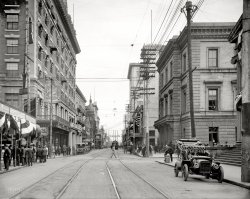
- Here Comes the Neighborhood
- ... to 1928. Maybe D.J. saw it on display at the Wardman Park Hotel "Closed Car Salon" -- click below to enlarge.
Velie Motors ... Posted by Dave - 09/04/2012 - 4:56pm -
![Here Comes the Neighborhood Washington, D.C., circa 1921. "Dunigan auto." The residential developer D.J. Dunigan with some of his creations. In back is the house we saw earlier today. The car is a circa 1921 Velie Six. National Photo Co. glass negative. View full size.
Velie sedanI think the car is an early 1920s Velie, a car made in Moline, Ill., by a cousin of John Deere, who invented the steel plow. Closed sedans were a luxury in the early days when most cars were open tourings or roadsters.
It might be a GardnerThe car looks like a 1920 or 1921 Gardner sedan, but I'm not positive.
Car IDI win! That's old man Dunigan's car.
The new closed VelieVelie seems to be the correct answer. This car had hundreds of ads in the Washington Post from 1910 to 1928. Maybe D.J. saw it on display at the Wardman Park Hotel "Closed Car Salon" -- click below to enlarge.
Velie MotorsVelie built 250,000-300,000 cars from 1909 until 1928, of which a couple hundred still exist.
The company also built aircraft and aircraft engines for several years. Its airplane business was sold and moved to St. Louis after Velie Motors closed, building Monocoupes until 1950 or so.
Velie Motors ended production of automobiles in 1928, a year before the death of company founder Willard Velie, a grandson of John Deere.
The front wall of the old Velie Carriage Works is all that remains, incorporated into the perimeter around the John Deere Planter Works on River Drive in Moline.
Where the streets have no nameThese look like good, solid houses that should still be around, so I went hunting on google/bing maps but came up empty.
Of course, numbered streets in DC are totally bizarre (18th, for example has a NE, NW and SE, and they start and stop and random locations), so it's not exactly simple. I don't envy the Washington postal carriers.
[The ever-resourceful Stanton Square found these houses on 16th Street NW in the previous post. - Dave]
Edit: Ah, thanks, missed that. They sure look smaller now than the old pix, but in nice condition.
View Larger Map
Love to find the car today.....Being able to see the house 82 years later via something that was never even dreamed is just beyond NEAT!
Love this website!
Why two?Ok, so it is a Velie, but why are there 2 license plates on the front and back?
[Back before the reciprocity laws, motor vehicles had to licensed in every state they were driven in. - Dave]
NomenclatureHow neat that the two door Velie sedan was known as the "Sociable Coupe"! I wonder if it had a bar in the back?
How gaucheIf there's anything I can't stand, it's dirty whitewalls.
Scary windowsThe cottage for sale has those scary quarter-round windows that will forever haunt me from the Amityville movies.
NeighborsI live two blocks from these houses. They're bigger than they appear, around 2,500 square feet and still in great shape.
(The Gallery, Cars, Trucks, Buses, D.C., Natl Photo)](https://www.shorpy.com/files/images/30239u.thumbnail.jpg)
- The Continental: 1947
- August 6, 1947. "Continental Hotel, Chicago." 45-story tower completed in 1929; the onion dome encloses a ... built by the Shriners organization in 1929, intended as a hotel and activity center for its membership. Note the parapet and crescent ... The building is now part of the Intercontinental Hotel.
In the foreground is what was a Chicago institution, Ray's Famous ... Posted by Dave - 09/17/2015 - 7:13pm -
![The Continental: 1947 August 6, 1947. "Continental Hotel, Chicago." 45-story tower completed in 1929; the onion dome encloses a spiral staircase leading to a small observatory. 4x5 acetate negative from the News Archive. View full size.
Beef MedallionsRay's Famous Steaks (112 E. Illinois) had its own currency.
America's answer To the leaning tower of Pisa
High ShrineThe building was originally the sumptuous Medinah Athletic Club, built by the Shriners organization in 1929, intended as a hotel and activity center for its membership. Note the parapet and crescent atop the building, long since removed, the latter part of Shriners heraldry.
The "small observatory" and parapet were originally intended for the docking of dirigibles. The building is now part of the Intercontinental Hotel.
In the foreground is what was a Chicago institution, Ray's Famous Steaks, on Illinois Street. Michigan Avenue has an upper and a lower level, which might confuse people looking at this photograph, since it appears the structure was built in front of a viaduct, which is actually Upper Michigan Avenue.
WGN ?Can anyone familiar with this area comment on the building seen to the right which seems to have the letters W G N which would be the call letters for the famous radio station owned by the Chicago Tribune (W)orlds (G)reatest (N)ewspaper. From what I understand, WGN broadcast from the Tribune Tower on Michigan Avenue. Maybe this is a transmitter station assuming that is an antenna at the extreme right of the photo?
[Those were the WGN radio and later TV studios in the Tribune Tower complex. -tterrace]
The WGN-AM transmitter at that time (and today) was located over twenty miles northwest of the Loop, near Itasca, on Route 53. It was built in 1938. Its previous transmitter was even farther to the northwest, in Elgin. The original WGN-TV studios were in cramped quarters in Tribune Tower from 1948 to 1961, at which point the entire Tribune broadcasting operation was moved to new studios on the North Side, north of Addison Street close to the North Branch of the Chicago River. The radio studios returned to Tribune Tower a few years ago. The original transmitter and tower for WGN-TV was at the old Daily News building in the West Loop, and moved to Tribune Tower in 1950, then to the Prudential Building in 1954. I believe it now resides atop the Sears, I mean, Willis Tower.
If this was the 60's BatmanThat would have to be the baddies hideout, tilted like that.
(The Gallery, Chicago, News Photo Archive)](https://www.shorpy.com/files/images/SHORPY-678.thumbnail.jpg)
- Perfect Diamonds: 1940
- ... in Washington, D.C., currently located in the Willard Hotel and Chevy Chase, MD. I also found an announcement in a March 1919 trade ... Posted by Dave - 09/15/2022 - 6:31pm -
![Perfect Diamonds: 1940 Washington, D.C., circa 1940. "Potomac Electric Power Co. -- Air Conditioning and Lighting -- Chas. Schwartz & Son, jewelers." 8x10 acetate negative by Theodor Horydczak. View full size.
Lump of coal- quite imperfect ! - would pretty well sum up the prior store
The firm added the 1305 F Street NW branch in 1940 -- three years after the namesake died (pehaps the kids wanted a more modern image) -- so if the date is correct actually 1940, the grand opening sign must have just been put away.
[To reiterate a point frequently iterated, "circa 1940" does not mean "in 1940." - Dave]
Breakfast at Schwartz's ... just doesn't have the same "ring" to it.
Glass brickWas a popular decorating motif in the late 30's, early 40's. Also I can almost guarantee that those Art Deco letters are the first four of the word "modern", which it certainly is for that time. Those curved show windows were also in style.
Subliminal advertisingI have no doubt the clock and small sign were illuminated. At night when you looked at the time you would also see "Schwartz Perfect Diamonds". I wonder if their name was in white neon script, like a perfect diamond.
I wasn't able to find an article about the modern, sleek building. I did find Charles Schwartz & Son is the oldest jeweler in Washington, D.C., currently located in the Willard Hotel and Chevy Chase, MD. I also found an announcement in a March 1919 trade paper. I bet Eugenia got a nice ring.
Street display has slanted windows ...I like walking past display windows that are slanted. It looks like I'm walking into myself.
[The windows are not slanted. - Dave]
Summer fashion in the street and in the windowWoman warring very similar style as mannequin in window.
["Warring" -- as in combat fatigues? - Dave]
Looks like a postmodern building nowThis beautiful little building is so 30's modern that it looks like a 1980's Post Modern building, like the Portland Building in my home town. With the interior, it's a unified statement of forward thinking. And the upper windows suggest a cut jewel, I suppose. And what about those two square tiles on each side of the clock? I often wonder how the sad jewelry stores I see in the malls survive nowadays.
(The Gallery, D.C., Stores & Markets, Theodor Horydczak)](https://www.shorpy.com/files/images/SHORPY-5a40907u.thumbnail.jpg)























